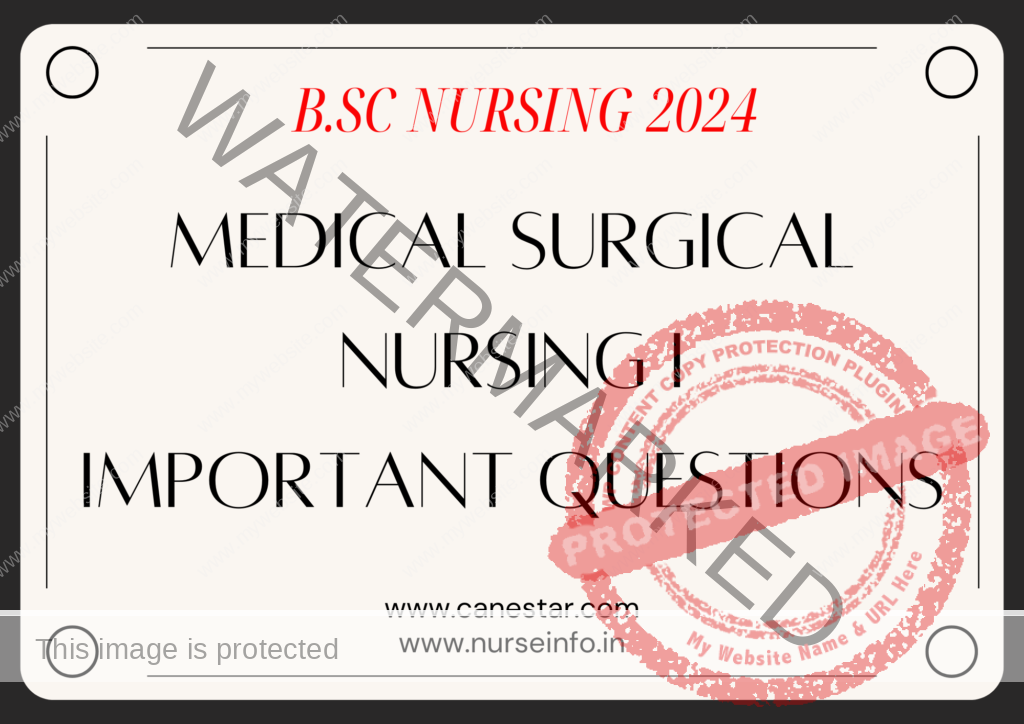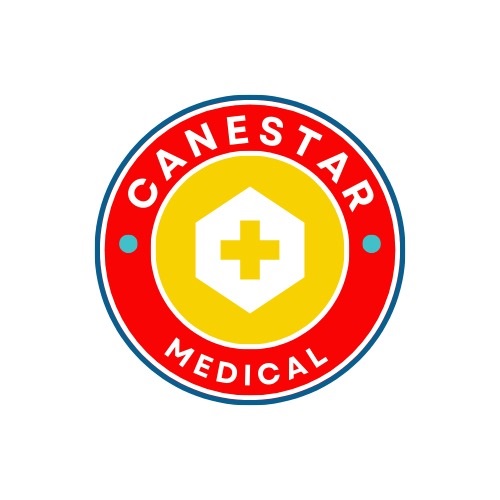MEDICAL SURGICAL NURSING I
IMPORTANT QUESTIONS
FOR BSC NURSING 2024
UNIT I-MEDICAL SURGICAL ASEPSIS
Immunity
Wound healing
Pre-operative preparation
UNIT II-COMMON SIGNS AND SYMPTOMS
Stages of Shock
Nursing management of the patient with unconsciousness.
Pain management
Edema (2 marks)
UNIT III-RESPIRATORY SYSTEM:
Bronchial asthma
COPD
Pulmonary tuberculosis.DOTS
Pleural effusion
Intercostal drainage
Pneumothorax (2 marks)
Tracheostomy
Mantoux test
Chest injuries.Haemothorax
Flail chest
UNIT IV-DIGESTIVE SYSTEM
Hiatal hernia
GERD
Peptic ulcer disease
Intestinal obstruction
Apeendicitis
Ulcerative colitis
Colostomy care
Endoscopy
2 marks:
Hemorrhoids
Anal fistula
Steatorrhea
Interssucption
Peritonitis
Dumping syndrome
HEPATOBILIARY SYSTEM
Cirrhosis of liver
Hepatic failure
Cholelithiasis
Esophageal varicies
2 marks
Pancreatitic cyst
Cholecystitis
Abscess
Ascitis
ESSAY TYPE
- Explain the pathophysiology and clinical manifestations of burns. Describe the management of patient for the first 24 hours. List the complications of burns
- Define hemiplegia. What are the causes, signs and symptoms? Explain in detail the management of client with hemiplegia
- Define mastoiditis. List the causes of mastoiditis. Explain the post operative nursing management of patient who has mastoidectomy
- Define CCF. Write the clinical manifestations based on pathophysiological changes. Explain the medical and nursing management of a patient by using nursing process
- Define ASOM. Explain the pathophysiology of ASOM. Write the nursing management of patient based on two priority problems
- Define COPD. List the clinical manifestations of COPD. Write in detail about pathophysiology of COPD
- Describe the causes of bronchitis. Explain the medical and nursing management of a client with bronchitis.
- Define epilepsy. Discuss the stages of convulsions. Explain the nursing management of a client during a convulsive attack
- Define hemiplegia. What are the causes, signs and symptoms? Explain in detail the management of a client with hemiplegia
- What are the causes of rheumatic heart disease? Enumerate the pathophysiological changes. Explain in detail the management of rheumatic heart disease.
- Define Glaucoma. What are the causes explain in detail, medical, surgical and nursing management
- What are the causes and signs and symptoms of glaucoma. Explain the treatment modalities. Explain he nurses role in rehabilitation.
- Explain the etiological factors of respiratory failure. Describe the medial and nursing management of a client with respiratory failure
- Define the term cerebrovascular accident CCVA. List the etiological factors and clinical manifestations of CVA.
- Explain the pathophysiological changes in chronic suppurative otitis media. Describe the medical and nursing management of patient. List the complications of chronic suppurative otitis media
- What is bronchial asthma. Explain pathophysiology and clinical manifestations in bronchial asthma. Describe the medical and nursing management of a patient with bronchial asthma
- Define meningitis. List out the etiological factors of meningitis. Explain the pathophysiological basis of signs and symptoms of meningitis. Write in detail the nursing care plan for a patient with meningitis.
- Discuss the risk factors, pathophysiology, clinical manifestations and the interventions during the acute phase of stroke. Write a note on the rehabilitative nursing interventions for a hemiplegic patient
- Discuss the types, manifestations and the surgical procedures of otitis media. Explain the rehabilitation of a hearing impaired person
- List the seven warning signs of cancer. Discuss the clinical manifestations and the chemotherapeutic intervention of acute leukemia. Write a note on bone marrow and stem cell transplantation
- What is cataract. What are the clinical features and diagnostic measures. Explain the surgical and nursing management of cataract
- Define myocardial Infarction. Enumerate etiology and risk factors of myocardial infarcation.
- Enumerate the clinical features of head injury. List the complications of head injury. Explain the nursing management of head injury for first 48 hours
- Define cataract. Discuss the surgical management of cataract. Explain the pre and post operative nursing management of patient
- Define tonsillitis. List the causes and complications of tonsillitis. Explain the nursing management of a patient for the first 24 hours after tonsillectomy
- List the warning signs of cancer. Briefly explain the modalities of treatment for patient with cancer. Explain the role of a nurse in palliative care
- Enlist the types of brain tumors. Differentiate benign and malignant tumors of brain. Explain the pre and post operative management of client undergoing craniostomy surgery for removal of brain tumor
- Discuss pathophysiology of EDH. Discuss the preparation of patient for craniotomy and evacuation of EDH
- What is tracheostomy. List the indications of tracheostomy. List the complications and nursing management of patient
- Define CVA. Clinical manifestations based on pathophysiological changes. Write the nursing management
- List the causes of RHD. Enumerate the pathophysiological changes. Explain in detail the management of RHD
SHORT ESSAYS
- Tonsillitis
- Epistaxis
- Guilliain – Barre syndrome
- Infertility
- Describe the role of nurse in disaster management
- National blindness control program
- Psychosocial aspects of cancer
- Staffing norms in critical care units
- Ethical and legal aspects in critical care units
- Types of deafness
- Mastoiditis
- Causes of blindness
- Surgical approaches of Glaucoma
- Pericarditis
- Bronchiectasis
- Nursing management of unconscious patient
- Multiple sclerosis
- Parkinson’s disease
- Nursing management of a patient with epileptic seizures
- Tracheostomy care
- Rhinitis
- Management of glaucoma
- Cardiac tamponade
- Mechanical ventilation
- Pathophysiology of COPD
- Levels of unconsciousness
- Quadriplegia
- Complications of PTB
- Etiology of coronary artery disease
- Foreign body in the eye
- Otitis media
- Laryngitis
- Deviated nasal septum
- Adenoiditis
- Pharyngitis
- Tonsillitis
- Cystic lung
- Cardiac arrest
- Hypoxia
- Nursing care of client with corneal injury
- Inter costal drainage
- Otosclerosis
- Urethral stricture
- Cystitis
- Metroragia
- Uterine displacement
- Encephalitis
- Mayasthenia gravis
- Cardiac pace maker
- Pharyngitis
- Hearing aids
- Complications of head injury
- Prosthetic heart valves
- Levels of unconsciousness
- Risk factors of coronary artery disease
- Cataract
- Corneal transplantation
- Deviated nasal septum
- Glasgow coma scale
- Intake and output chart
- Corticosteroids
- Cranial nerve examination
- Crisis intervention
- Impacted wax
- Refractive errors
- Psychosocial impact of serious burns
- Cerebral angiography
- Explain clinical features and management of glaucoma.
- Explain the pre operative and post operative management of a patient with tonsillectomy
- Explain the management of Menniers disease
- Nursing management of patient with Pleural effusion
- Causes and diagnostic evaluation in endocarditis
- Clinical features and management of bronchial asthma
- Nursing management of hemiplegia
- Nursing care after Laminectomy
- Nursing care of unconscious patient
- Health education for a patient with epilepsy
- Pathophysiology changes in glaucoma
- Nursing management of a patient with tracheostomy
- Steps of breast self examination
- Chronic otitis media
- Common side effects of chemotherapy and its management
- Common health problems of the elderly and its management
- Infection control in critical care unit
- Causes and types of disaster
- What are causes of meningitis
- Explain the types of hearing loss
- Explain the medical and nursing management of a client with parkinson’s disease
- Define Dysmenorrhea. List the clinical manifestations and explain the management
- Define contraception. Explain the spacing methods and permanent methods of contraception
- Methods of infection control in critical care unit
- List the types of radiotherapy and complications associated with it
- What is a Snellen’s chart? Explain the types of refractive errors of eye
- Explain the non pharmacological measures of pain reduction
- Stem cell therapy
- Clinical features of meningitis
- Reconstructive surgeries
- Post traumatic stress disorder
- Food poisoning
- Lumbar puncture
- Aphasias
- Injuries and infections of eye
- Endocarditis
- Cardiac catheterization
- Electrocardiogram
- Respiratory failure
- Drugs used in pulmonary tuberculosis
- Deviated Nasal Septum
- Drugs used in cardiology
- Level of unconsciousness
- Otosclerosis
- Retinal detachment
- Alzheimer’s disease
- Permanent methods of sterilization
- Physical setup of critical care units
- Respiratory emergencies
- Principles of critical care nursing
- CPR – advance cardiac life support
SHORT ANSWERS
- Tympanic membrane perforation
- Delirium
- Cystocele
- Autograft
- Radiography
- Mantoux test
- Electroencephalography (EEG)
- Metrorrhagia
- Pathophysiology of multiple sclerosis
- Implanted hearing devices
- Quinsy
- Eye irrigation
- Intra Ocular Pressure
- Emphysema
- Adenoiditis
- Snellen’s Chart
- Epistaxis
- Paraplegia
- Brain Abscess
- Aphasia
- Arterial blood gas analysis
- Home care of Ac. Pharyngitis
- Defibrillation
- Signs and symptoms of spinal cord compression
- Complications of laryngitis
- Indications of corneal transplant
- Rehabilitation for blindness
- Signs and symptoms of cardiac arrest
- Pathophysiology of Atelectasis
- Cerebrospinal fluid analysis
- Endocarditis
- Epilepsy
- Aphasia
- Emphysema
- Atelectasis
- Cerebral compression
- Sinusitis
- Myocarditis
- Cataract
- Cornea
- Warning signs of carcinoma
- Preoperative preparation of keratoplasty
- Foreign body in ear
- Local anesthetic agents
- Role of surgery in carcinoma
- Echo cardiogram
- History taking
- Scrubbing
- Surgical asepsis pneumothorax
- Intensive care records
- Aphasia
- Quadriplegia
- Mantoux test
- Meningitis
- Quinsy
- Infections of eye
- Digoxin
- Tonometry
- Amenorrhoea
- Radiotherapy
- Frost bite
- Post traumatic stress disorder
- Epistaxis
- Audiogram
- Infertility
- TNM staging system
- Neurogenic shock
- Cushing’s ulcer (stress ulcers)
- Types of meningitis
- Components of Glasgow coma scale
- Clinical features of cystic fibrosis
- Define emphysema
- Indications to measure central venous pressure (CVP)
- Indications for Tread Mill Test (TMT)
- How to remove foreign bodies from the eye?
- Causes of Epistaxis
- What is a Nasal polyp
- List the cardinal features of meningitis
- List the principles of critical care
- Define infertility. List the causes
- Hospice care
- Dementia
- Quadriplegia
- Dysmenorrhoea
- Peritonsillar abscess
- Define Pap smear. List the indications of PAP smear
- What is Stem Cell therapy
- What is Mammography and list the indications for Mammography
- The types of burns reconstructive surgeries
- List the principles of critical care
- Mention any four anti epileptic drugs with the dosage
- What is Rectocele and Cystocele
- Any two formulas for fluid calculation in burns
- Dementia
- Defibrillation
- Increased ICP
- Eye banking
- Industrial health disorders
- Conjunctivitis
- Sinusitis
- Signs and symptoms of parkinson’s disease
- Fine needle aspiration
- Lumbar puncture
- Pre operative teaching
- Signs and symptoms of cardiac arrest
- Meniere’s disease
- Laryngeal obstruction
- Headache
- Chorea
- Toxic shock syndrome
- Immunotherapy
- Policies of critical care units
- Cognitive aspects of aging
- Paraplegia
- Emphysema

